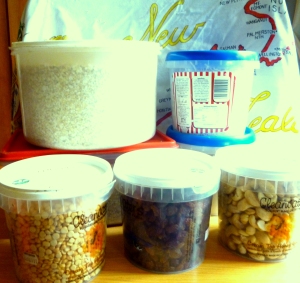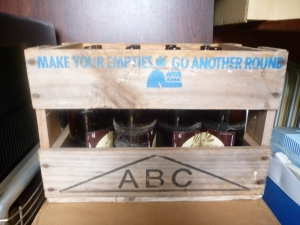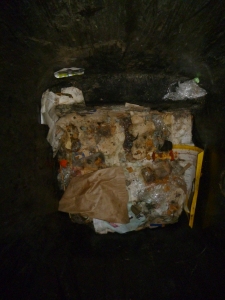by Dr. Sharon McIver – First published by carbonnews.co.nz 17th August 2015
Pollution from plastics is one of the biggest environmental crises the world faces. The C02 emissions released during the production, transport, and recycling stages is damaging enough, but plastic’s poisonous reach goes far beyond the sky and raised sea levels. It leaches chemicals in landfills, chokes waterways and causes floods, and once in the ocean, kills vast quantities of sea-life and enters our food chain.
Beyond environmentalism however, our continued use of it makes no economic sense in the face of peak oil – if we must continue to use oil, and not keep it in the ground, then surely it can be better applied to a host of other industries than producing mountains of packaging that only gets used once.
I sort through rubbish bins. I do not work at a recycling plant, but my empathy goes out to anyone who does – trash (whatever its stream) is disgusting and I cannot imagine what it must do to one’s soul to work amongst mountains of it every day. I only deal in bin or skip loads at a time (and it’s usually fresh), but every piece of plastic I handle makes me feel a little sadder for humanity.
So why do I do it? Firstly, I want to live in a world where disposable plastic does not exist, and secondly, I have found a way to make a living out it. My waste prevention and recycling consultancy Our Daily Waste specialises in customised recycling signage, which helps reduce contamination so that recycling will get recycled. We also run recycling systems at events, where we divert as much as we can from landfill, and remove all contamination through constant sorting of bins.
Recycling is not sustainable
Yet the list of what is recyclable is shrinking rapidly, and much of it is so contaminated that the buyers are rejecting vast quantities, which must then be sent to landfill. What is and is not recyclable is different around the country, and depends on what your local council or waste company can find buyers for, and the vast majority of it is shipped offshore, much of it to China.
Even aluminium, which when recycled saves 95% of the energy and CO2 emissions required to process primary product, is mostly sent overseas, and that is only the 48% of it that does get recycled. According to 2010 figures listed on the Smart Packaging website, less than 1% of aluminium manufactured at Tiwai Point in Southland is from recycled product.
Hence, it is a fallacy that recycling is environmentally or economically sustainable. It requires fuel to transport, sort, process into raw materials, and reprocess back into something that will probably not be recycled again, all of which is increasing CO2 emissions. Even recycled plastics will eventually be discarded or become eroded, degrading into microfibers that poison our soil and oceans. In the case of popular recycled goods such as polar fleece and minky blankets, the microfibers are being washed into the waterways via our washing machines while the items are still in use (http://www.theguardian.com/sustainable-business/2014/oct/27/toxic-plastic-synthetic-microscopic-oceans-microbeads-microfibers-food-chain).
Even so, recycling is still better than using virgin resources, and it helps us conserve our remaining oil. It is also better than litter or landfill, and we need to do something to try and reduce the 2.5million tonnes of landfill New Zealanders dump every year and the damage that causes to the environment and atmosphere.
The end of oil
Rob Hopkins, founder of the transition movement (which assists communities to shift from oil dependency to local resilience) writes in his 2008 book The Transition Handbook that although researchers could not agree on when peak oil would occur, the majority of estimates were falling: “between 2010 and 2015, with very few credible researchers placing their forecasts beyond this 2020 bookend. Having said that, the exact date of peak oil is really not so important. What matters is the fact it is inevitable . . . and we haven’t even begun to think about what we might do about it.” (2008: Totnes: Green Books Ltd. p. 29)
Two years ago I did a business course and was asked what the biggest threat to my social enterprise was. “That I’m successful,” was my reply. The Our Daily Waste mission is to eliminate waste from Aotearoa, and if we do that then we could be out of business. However, seeing that virtually every industry creates waste, and that our speciality – packaging – now includes things like Nespresso pods and supermarket giveaways, that scenario is a long way off. I will also be in a position to see it coming and will diversify appropriately.
And this is what I do not understand about the companies that manufacture, process, and use plastic. They know that at some point the raw materials will become prohibitively expensive, and eventually run out altogether, yet they are not finding ways to diversify into reusable, or truly recyclable products (such as aluminium) before that happens.
Legislation to ban disposable plastic would go a long way towards encouraging industry to find solutions, but going by National’s recent announcement that rather than an outright ban on plastic bags they will trial a recycling scheme for all plastic packaging, New Zealand will not be joining the ranks of countries such as Germany, South Africa, and Italy any time soon. For those of us working to reduce plastic, the irony was not lost that a scheme placing the onus on consumers (rather than industry) was released during Plastic Free July. The Auckland trial relies on consumers taking their packaging back to the supermarket, but from my experience of people’s ability to provide clean recycling, it will have to be tightly managed for it to work, and I doubt whether there is funding for that (https://ourdailywaste.co.nz/2015/08/03/plastic-shamtastic-why-we-need-legislation-to-reduce-plastic-not-just-recycle-it/).
Hence it is up to industry and consumers to find a way through this – the industry by offering goods wrapped in non-plastic packaging, and the consumers by refusing to buy anything that is not.
Brand recognition
As consumers we have little choice but to go along with the packaging available. I would love to be fully plastic free, but the harsh reality is it takes time, planning, and often costs more, and my energy is better spent trying to change the infrastructure.
Plastic packagers should be wary of where their logo ends up (think of all those supermarket bags used for dog turds). Sorting bins or picking up litter can be tedious, so I amuse myself by reading logos and promotional blurbs, and attaching a meaning that inverts the intentions of the company (as in “nothing says death and decay quite like a Mother Earth wrapper slowly degrading on the beach”). If I find a particularly offensive rubbish item I share my thoughts about it on my social media pages, and the best examples are used for public talks where I teach other people to make these connections also.
I began the waste reduction journey 15 years ago, but the plethora of websites and social media pages now dedicated to the subject indicates that I am no longer an anomaly. And, whilst we may represent a small percentage of shoppers overall, the businesses that support our quest for better (or no) packaging earn the kind of loyalty that most retailers dream of. For me, buying things in reusable containers and then taking them to bulk food stores such as Bin Inn has had the biggest impact, but there are other brands I am loyal to because they provide reusable, or low waste alternatives, including Soapnuts, GoBamboo, Harrington’s, and Ecostore.
Elsewhere, I choose brands that use glass, aluminium, tin, cardboard, or paper packaging, all of which are recyclable, or compostable. When I shop at Farmers’ Markets I take reusable veggie bags, and I support the stalls where packaging is optional, avoiding altogether those that bag up the majority of their produce. The stalls I buy from may not be making a huge profit, but because of their ecological principles they are more likely to survive economic or environmental collapse.
Waste Prevention
So what can a business do to earn lifelong loyalty from buyers like myself, and futureproof their packaging?
The answers of course lie in the past, some of it not that distant. Plastic soda water bottles became commercially viable in the 1960s when polyethylene was invented, but were not commonly used here until the 1980’s. Hence, my childhood is bright with memories of finding glass ‘fizzy drink’ bottles in the park and spending the refund on lollies. The butcher wrapped our meat in newsprint, and everything in the hardware or haberdashery stores was measured and put into paper bags which were used to start the fire.
Go back further and you find cheese wrapped in muslin, wax or leaves; liquids decanted into earthenware or metal containers; and wine stored in animal skins.
Of course, the argument for changing to plastic was all about hygiene and I understand that some of these options are untenable for health and safety reasons, but ironically we now have less exposure to germs to build antibodies, and are also at risk from the petrochemicals that leach into our food via the plastic. The answers we seek lay in using our access to technology and centuries of ideas to find solutions that borrow from the past but satisfy our higher expectations of what packaging should do.
Reusing glass is an obvious solution. It can be sterilised easily and is attractive. In Germany they have beer centres where bottles are washed, refilled, capped and sent out, with each brewery having its own distinctive bottle. Because the beer is available in crates, support of local breweries has increased (http://inhabitat.com/packaging-the-future-packaging-reuse-what-a-concept/starregermanybeercrop/).
We should be able to buy anything that can be bottled in reusable glass, but wouldn’t it be great if we could also buy goods in jars that could be reused as well? If enough businesses switched to these products there would be a demand for localised glass sterilisation plants, and perhaps even beer centres.
In Christchurch, the Nature Matters Milk Company have been delivering milk to cafés in stainless steel urns, which saves the space required to store and dispose of all that plastic, and they have plans to put in vending machines using reusable glass bottles. Using a mobile milking and pasteurising station where the milk is pasteurised instantly and bottled within minutes, along with sustainable farming practices, the milk is considered to be a high quality and perfect for frothing.
Cafés are also leading the charge by selling reusable takeaway cups, and many of those selling their own beans also sell or provide reusable tins, ensuring that their logo is seen every time their customers make a coffee.
Environmental branding
Reusable items such as cups, water bottles, cutlery and stainless steel takeaway containers offer premium branding opportunities where your logo is seen repeatedly, and associated with innovative and ecologically principled thinking.
For non-food packaging, businesses selling items that can be weighed, measured, or counted (hardware, crafts, feed stores) could sell first fills in attractive reusable packaging such as buckets, tins, jars, cotton zip bags etc., and then offer discounts when people bring them back. Buying items without all the bulky packaging also reduces shipping volumes and transport costs.
Given the extraordinary marketing and brand loyalty opportunities of reusable packaging, it is surprising that it has not already been dreamed up by the 21st Century equivalents of Mad Men executives.
The Edmonds ‘Sure to Rise’ logo became iconic in New Zealand, not because of the quality of the baking powder, but because of the tin. Instead of having your packaging ripped apart and crumpled before being discarded (or worse), think about how your logo would look displayed in cupboards and tool sheds for years to come – an example of packaging that cares about the future.








